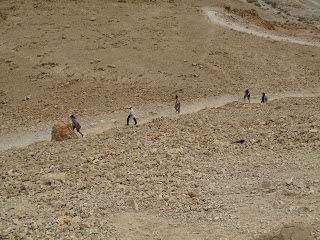One of our first days in Kenya, Erin and I found a really great (and free!) photography exhibit called Kenya Burning that chronicles the violence that took place in Kenya during the 2007 elections. It was a real eye opener for me because although I had followed the post-election rioting in the news I don't think that it really sunk in just how widespread the violence was, and just how close Kenya came to the brink of disaster.
It was interesting to see how immediate the local media's response was to the crisis. The exhibit had a film of interviews with many of the local journalists and photographers who documented the violence and it was a huge reminder for me about the power that a free press has to really change the course of history. During the crisis, the Kenyan radio was constantly broadcasting messages throughout the country urging moderation and warning Kenyans how closely the situation resembled the early stages of Rwanda -- which is so different from the way that Rwandan radio messages were used to fuel the violence during the genocide there.
There is something surreal about seeing such graphic depictions of violence and then realizing that it happened so recently. On the one hand, I was impressed at how transparent the exhibit was -- it certainly didn't sugar coat anything and I think that in general it says a lot about the society's resiliency that it is already reflecting on and trying to come to terms with such a traumatic time. On the other hand, in talking to most Kenyans we've spoken to there is still a fair bit of pessimism and mistrust in the government. There also seems to be a general sense of fear that the worst may be yet to come with the next round of elections, as very little has changed to address people's concerns about corruption in the government.
And on a day-to-day basis people's lives continue to be impacted by the violence because of its impact on the local economy. Even for low season it seems incredible that in most of the cities we've gone to in Kenya we've only bumped into a handful of other tourists. For the local vendors, this means that they have fewer opportunities to make a buck -- for us tourists it means that every time we leave our hotel we are accosted by at least 10 people trying to hawk the same kitschy crafts.
And on a day-to-day basis people's lives continue to be impacted by the violence because of its impact on the local economy. Even for low season it seems incredible that in most of the cities we've gone to in Kenya we've only bumped into a handful of other tourists. For the local vendors, this means that they have fewer opportunities to make a buck -- for us tourists it means that every time we leave our hotel we are accosted by at least 10 people trying to hawk the same kitschy crafts.
 Here's an aerial of the community we saw. If you zoom in (however you do that) you can get a bit of a sense of the neighborhood. Pigs in the back yard, trash everywhere, goats on the roof... etc. Sorry it's the only one! Go buy some recycled fabric bags!
Here's an aerial of the community we saw. If you zoom in (however you do that) you can get a bit of a sense of the neighborhood. Pigs in the back yard, trash everywhere, goats on the roof... etc. Sorry it's the only one! Go buy some recycled fabric bags!
 Ladies at Sindyanna making an order of Ten Thousand Villages olive oil soap... get yours at tenthousandvillages.com!
Ladies at Sindyanna making an order of Ten Thousand Villages olive oil soap... get yours at tenthousandvillages.com! The Yokel family survives the trek up Mosada.
The Yokel family survives the trek up Mosada.
